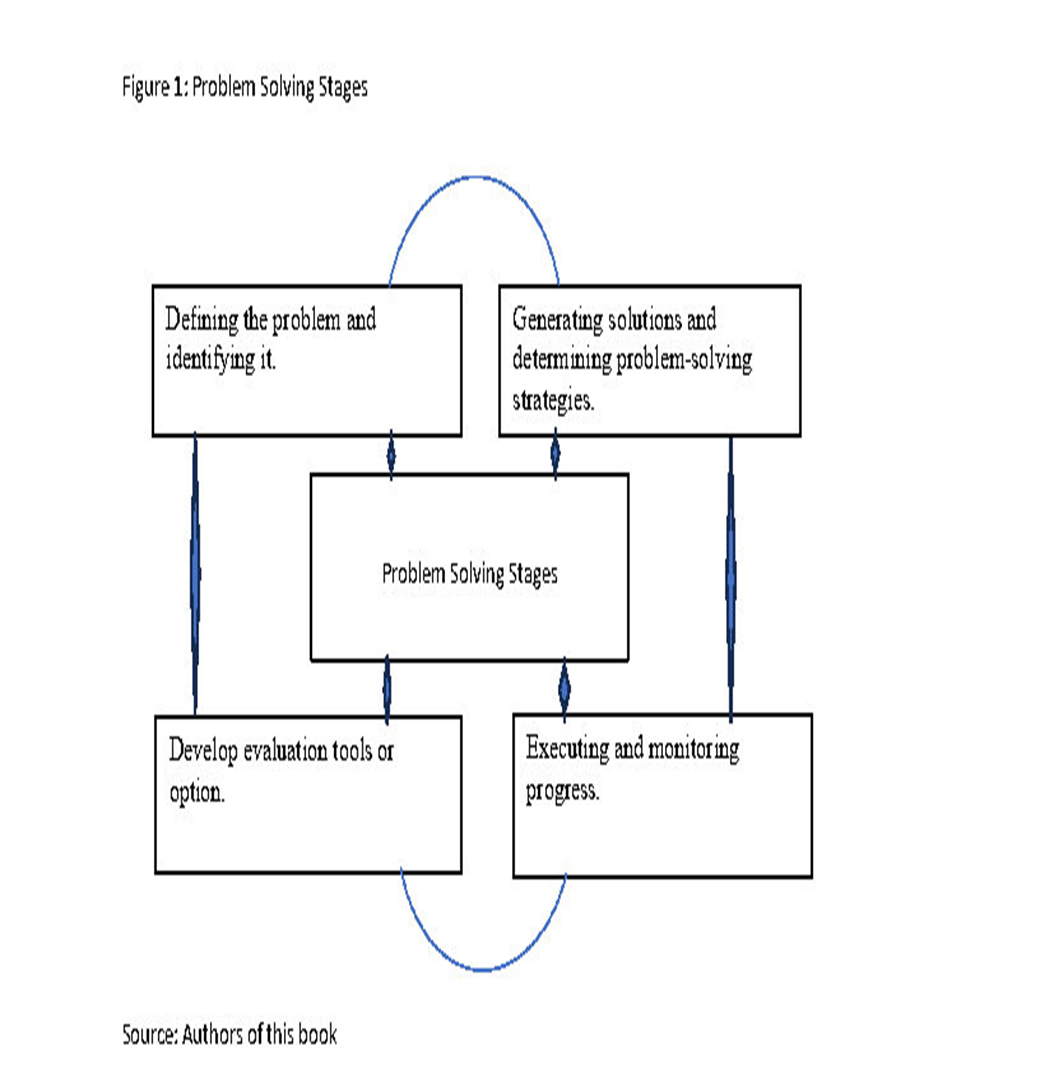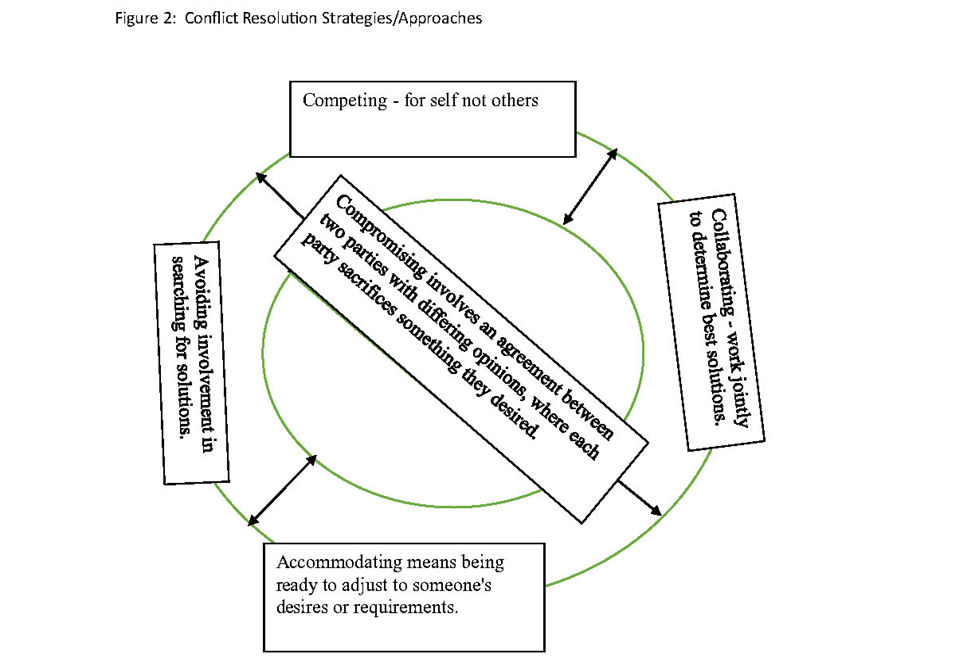Conflict and Problem Solving
A key aspect of helping clients will be problem solving and, to a lesser extent, conflict resolution. According to The BC Provincial Cook Articulation Committee (2015), the most effective problem solving method uses both rational and intuitive or creative approaches. There are six steps in the process
-
- Identify the problem.
- Search for alternatives.
- Weigh the alternatives.
- Make a choice.
- Implement the choice.
- Evaluate the results and, if necessary, start the process again (para. 2).
Kim et al. (2018) explained that solving problems means recognizing and dealing with unfamiliar processes and goals in a specific context. To enhance problem solving, select the correct method and input a flexible process structure. This skill is essential to innovate thinking, produce favourable outcomes, and minimize negative effects in the face of rapid change.
As Kim et al. (2018) suggested, the first stage in problem solving is the selection of the correct method. This is important because problems cannot be solved without identifying a method that will lead to a successful solution. The second step is to determine the input, which means identifying suggestions or information that will aid in solving the problem. The input comes from the people in conflict and the support team, who can help to find a solution. The last stage is the establishment of a flexible process structure to implement the input and reach a solution without rigidity. Flexibility improves performance and lowers the risk of failure.
Amiel (2023) defined problem solving as “the act of defining a problem; determining the cause of the problem; identifying, prioritizing, and selecting alternatives for a solution; and implementing a solution” (para. 1). Figure 1 below summarizes the stages of problem solving.
The process begins with defining the problem; defining it helps to determine the impact the problem might have on the people who are facing it. A definition leads to the generation of ideas, which involves brainstorming or suggesting ideas to determine the best solutions. Once possible solutions are identified, they need to be evaluated to determine their effectiveness and the resources required to move forward, which can be both material and human. After the process of evaluation and the selection of possible solutions, the next stage is the implementation of the solutions. Ongoing evaluations must be carried out to ensure that the problem is solved. If it is not, it is necessary to return to the first stage to identify why the solution was unsuccessful.

Conflict resolution is a more precise skill than problem solving, and is often only undertaken with proper training. According to Barsky (2016), “Social conflict may arise because of perceived differences in relation to values, needs, goals, interests, rights, positions, or wishes. Many roles in the helping field require the use of conflict management methods, including negotiation, mediation, advocacy, group facilitation, family group conferencing, healing circles, and evaluation” (para. 1). Although the role of a CSW will not be to undergo this level of conflict resolution, understanding how conflict arises and what options are available to minimize conflict is beneficial.
In the field of community support work, conflict may be interpersonal, that is between a client and others; between the client and the CSW; or potentially between a CSW and the treatment team or other professionals. The process or model used to solve these conflicts differs depending on the circumstance.
Michel (2019) stated that conflict is “goal-seeking behaviour that strives to reduce the gains available to others to impede their want-satisfaction”. He added that conflict and cooperation are different things: “When actors adjust their behaviour to the actual or anticipated preferences of others through a process of policy coordination” (PPT slide 5) they demonstrate cooperation. Michel concluded that working together leads to mutual benefits, allowing everyone to prosper, although not necessarily equally, whereas conflict does not.
Wellingtone (2022) listed five methods of conflict resolution (see Figure 2). In competing, the first method, people might be fighting or disagreeing with one another and defending their sides with or without facts. Each side wants to be a winner because there are no opportunities to solve their disagreement. Both sides become argumentative, prepared to disagree or engage in arguments with others. As a result, solutions to the problem are not reached.
The second method is avoiding, which occurs when people in conflict avoid meeting or discussing their conflict, even if someone offers to unite them to solve their problems. Like competing, avoiding does not solve problems or conflict, but allows the conflict to continue.
The third method is collaborating, where people in conflict jointly work together under a coordinator or creatively solve the problem themselves.
The fourth method is accommodating, where people in conflict accommodate each other, enabling each of them to feel good because of their accommodation.
The fifth way is compromising, which refers to people in conflict agreeing to discuss their problems freely to reach solutions that are preferable to both sides.

References
Amiel, J.-P. (2023, January 25). ASQ—Problem solving tools resources: Problem solving (1). American Society for Quality. https://my.asq.org/blogs/jean-pierre-amiel/2023/01/25/asq-problem-solving-tools-resources-problem-solving-1?hlmlt=BL
Barsky, A. (2016, July 27). Conflict resolution. Oxford Bibliographies. https://www.oxfordbibliographies.com/display/document/obo-9780195389678/obo-9780195389678-0026.xml
Kim, J. Y., Choi, D. S., Sung, C-. S, & Park, J. Y. (2018). The role of problem-solving ability on innovative behavior and opportunity recognition in university students. Journal of Open Innovation: Technology, Market, and Complexity, 4(1), 1–13. https://doi.org/10.1186/s40852-018-0085-4
Michel, K. (2019). Key topics and contemporary issues: Conflict. OER Commons. https://oercommons.org/courseware/lesson/60569/overview
The BC Provincial Cook Articulation Committee. (2015). Working in the food service industry. BCcampus. https://opentextbc.ca/workinginfoodserviceindustry/
Wellingtone. (2022, May 30). Five methods for conflict resolution. https://wellingtone.co.uk/conflict-resolution/
Image Credit
Figure 1: Problem solving stages by Janna McCaskill and Leonce Rushubirwa for NorQuest College. Used with permission.
Figure 2: Conflict resolution stages / strategies by Janna McCaskill and Leonce Rushubirwa for NorQuest College. Used with permission.

